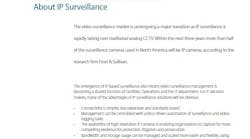What Decision Makers Need to Know About IP Surveillance
The emergence of IP-based surveillance also means video surveillance management is
becoming a shared function of Facilities, Operations and the IT department. For IT decision makers, many of the advantages of IP surveillance solutions will be obvious:
• Connectivity is simpler, less expensive and standards-based
• Management can be centralized with policy-driven automation of surveillance and video-logging tasks
• The availability of high-resolution IP cameras is enabling organizations to capture far more compelling evidence for protection, litigation and prosecution
• Bandwidth and storage usage can be managed and scaled more easily and flexibly, using open standards
The automation and scalability that comes with IP surveillance is also expanding the range of video surveillance applications – whether they are for security, crime prevention and detection, monitoring of staff and facilities, or applications specific to vertical industries such as shrinkage control for retail or risk management in healthcare.
For both IT decision makers and facilities or operations managers, the question is not whether IP surveillance offers the best solution. The question is how to build an IP surveillance solution that meets all the needs of your organization.
